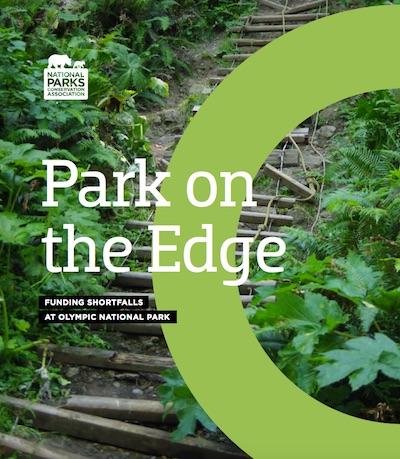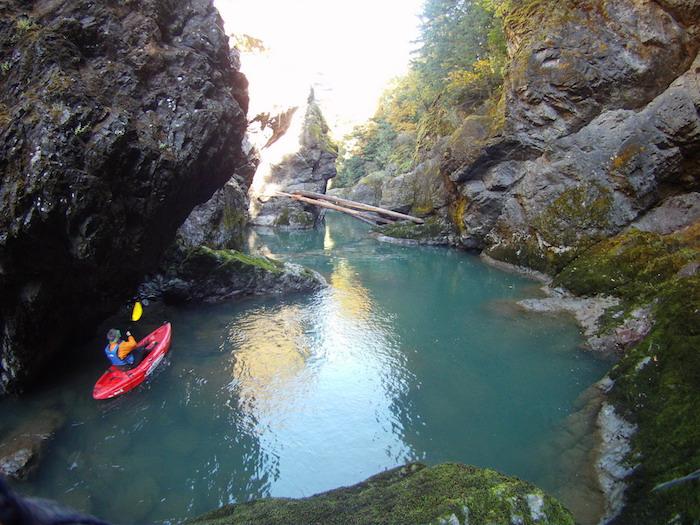
More and more people are visiting national parks, media channels are flooding consumer publications with features on the parks, congressional interest seems higher than ususal, and yet parks are struggling to get by, according to the National Parks Conservation Association.
The parks advocacy group points to Olympic National Park as just one example of the funding struggles pulling at the National Park System. According to the group, Olympic "receives only approximately 60 percent of the funds it needs to adequately serve visitors, maintain roads and trails, and protect internationally recognized natural resources."
The report comes as members of Congress work to strike a spending deal to provide funding for our national parks and other federal programs and agencies with a looming December 11 deadline, and as the National Park Service rapidly approaches its 100th anniversary in 2016, an NPCA release notes.
In a special report, Park on the Edge, NPCA officials say years of inadequate funding "have led to Olympic National Park’s $133 million buildup of maintenance needs for trails, visitor centers and other facilities – contributing to the more than $11 billion backlog across the National Park System.
The report reads much like the old "State of the Parks" reports NPCA once produced. Those studies examined individual park's staffing, maintenance, how they were meeting, or not meeting, their core missions, and more. For instance, in one report on Big Bend National Park, released in December 2006, the writers noted that:
• The once-wild Rio Grande, forming 118 miles of the border between the park and Mexico, is seriously degraded by upstream diversion of its waters and by pollution on both sides.
• Emissions from coal-fired power plants and other industrial sources in the United States and Mexico have dramatically diminished air quality and visibility at the park.
• Big Bend harbors 1,465 recorded archaeological sites, but only 3 percent of the park has been intensively surveyed. It is estimated that 10,000 to 20,000 archaeological sites actually exist in the park.
• While numerous historic structures and ruins in the park testify to the area’s former residents, the Park Service lacks the resources needed to document the condition of these structures. Funding and staffing shortfalls have allowed a number of these nationally significant structures to fall into disrepair.
• The park faces an acute shortage of financial and staff resources required to carry out complex resource protection and visitor services responsibilities. Big Bend’s 2000 Business Plan identifies an annual operational funding shortfall of $6.1 million and the need for about 70 additional full-time equivalent staff members.
The latest report on Olympic National Park includes four case studies, focusing on the Elwha River, Hurricane Ridge, coastal regions, and the Hoh Rainforest.
* Elwha River: The largest dam removal in U.S. history occurred within Olympic National Park, at the Glines and Elwha dams. This project has allowed for salmon to return to their historic spawning grounds and is marking a vast revegetation of the area. However, a relatively small amount of additional funds are needed to complete the revegetation of the area and allow continued scientific monitoring and research in the region.
* Hoh Rainforest: A newly renovated visitor center opened in this iconic section of the park in June of 2015; however, due to lack of additional funding only allows for one ranger to staff this center to greet and provide information to visitors most times of the year. Further, it opened without any new exhibits.
* Hurricane Ridge: For much of the winter, the stunning views and visitor center at Hurricane Ridge are left inaccessible to most visitors, as funds only allow for the road to be plowed three days per week.
* Wilderness Coast: Years of underfunding has taken its toll on weather-beaten trails, with not enough funding to provide staff to maintain them. While volunteers contribute 12,000 hours annually to help with maintenance, supporting such efforts with recruiting and management also requires funding. A $200,000 annual influx could completely support the staff needed to maintain the trails for the safety of visitors as well as to prevent damage to park resources.
You can download the full report here.

Removal of dams along the Elwha River watershed has opened up the area to recreation and helped restore key salmon fisheries/NPCA
“With years of insufficient funding, Olympic National Park is facing challenges that we sadly see across our National Park System – and it is time for Congress to write a new story for our national treasures,” said Rob Smith, NPCA's Northwest regional director. “Investing in Olympic and our national parks helps is good for visitors, good for protecting world-class natural resources for future generations, and good for regional jobs and businesses – a triple win.”
Each year, 3.2-million recreational visits generate $264 million in spending in gateway communities, such as Port Angeles, Forks, and Sequim, contributing to over 3,600 jobs. The park’s popularity continues to grow, with June visits up 40 percent this year and a 77 percent increase overall in campground attendance.
“Olympic National Park is vital to the economic well-being for the community of Port Angeles,” said Russ Veenema, executive director of the Port Angeles Regional Chamber of Commerce. “The park rangers do a good job of caring for Olympic with the resources available, but it is up to us citizens and business leaders to advocate for more appropriate funding levels.”
The upcoming 100th anniversary of the Park Service is an opportunity to begin to restore funding for Olympic and other national treasures across the country. The spending bill currently under consideration is the first of many opportunities to fulfill a vision of vibrant and healthy national parks that protect our heritage and serve millions of families each year.



Comments
Yet our national parks are only a small fraction of the overall neglect of America. Besides parks, much of the nation's infrastructure is slowly crumbling and very few citizens notice. Thousands of highway bridges, to cite only one of literally thousands of examples, are crumbling as are water systems, sewage pipes, and . . . . .. . well, you name it and it probably is suffering in some way.
We demand services from our government and then turn around and resist paying for all we demand.
It makes no sense whatsoever.
Even more alarming is the fact that the vast majority of Americans are blissfully unaware of the degrading world around us. As long as we're entertained --- and not having to pay any higher taxes or use fees --- we're mindlessly happy.
I can't speak to the adequacy of Olympic's funding, since like most NPS units, there is little or no transparency regarding finances. What federal agency ever thinks its allocation is adequate? I'd bet there are very few examples of bureaucracies (or their fellow-travelers like NPCA) issuing press releases admitting that the country has more serious problems and they have enough to get by.
I worked on the Olympic trail crew for over twenty years and have a much different perspective on the NPS maintenance backlog. We never came close to maintaining the existing 600 miles of trail, including several hundred bridges and over ten miles of boardwalk. Perhaps a hundred of those miles were never maintained at all, and another hundred only every few years. Yet every one of those years the trail crew spent up to a third of its time building new high standard frontcountry 'Nature Trails'.
In my experience, the itinerant NPS manager-class did not understand, or care if they did, that maintenance is not new construction or elaborate upgrades. Their institutionalized pursuit of MORE (and the promotions that went with it) diverted resources from existing infrastructure while creating ever more infrastructure to maintain in the long term. I think this has happened nationwide and has been the primary source of the multi-billion dollar maintenance backlog.
So NPCA, let me fix your press release: “With years of mismanagement, Olympic National Park is facing challenges that we sadly see across our National Park System..."